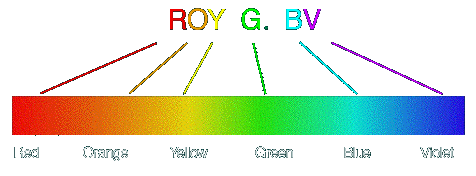
 The rainbow seen in the sky is actually the spectrum of the
Sun. Rainbows can also be created by passing light from an
incadescent bulb (for example) through a prism. If one looks
carefully at the spectrum of the Sun (a very dispersed spectrum -
the rainbow outside won't do), one notices that the it is not a
complete rainbow, like the lightbulb. There are sections of the
spectrum that are missing.
The rainbow seen in the sky is actually the spectrum of the
Sun. Rainbows can also be created by passing light from an
incadescent bulb (for example) through a prism. If one looks
carefully at the spectrum of the Sun (a very dispersed spectrum -
the rainbow outside won't do), one notices that the it is not a
complete rainbow, like the lightbulb. There are sections of the
spectrum that are missing.

These missing sections a the result of atoms between you and the core of the Sun that have absorbed very specific colors of light. To understand why this happens, let us learn a little about how atoms work. We will return to the rainbow of the Sun later.
If one takes a tube filled with, say, hydrogen (or any element or chemical) and runs electricity through it, the tube will glow with a very unique color. Passing this light through a prism (or similar device), you will find that the "rainbow" of the element is composed of discrete and completely unique pattern of colors. This uniqueness of an extremely powerful tool - it is a fingerprint that can be used to identify a particular (any!) element or chemical - hydrogen, helium, lithium, sodium chloride (table salt), carbon dioxide (the stuff you exhale), oxyhemoglobin (the stuff that makes your blood red), chlorophyll (the stuff that makes plant green), methane, amonia, etc.